Handball drills
- All players line up with the ball near the centre line
- Everyone takes turns to throw at the goal
- Throwing from position, from the run and with a jump shot
- Pay attention to the way of throwing
- B1 plays on point.
- Runs through and receives the ball in the run and finishes with a running shot.
- R1 blocks the ball. (jumping and forearms against each other)
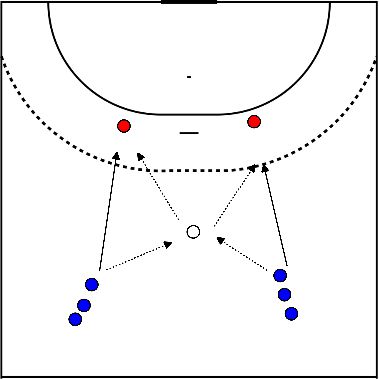
- The field players make 2 rows at the height of the posts.
- The balls are shot at the goal at the pace of the goalkeepers.
- Left high, right high, left high etc.
- However, when the players have taken a shot they do not calmly take the ball but sprint to the half way line.
- Variation:
- Another point can also be indicated by means of a
- pawn
- hat
- pole etc.
- Instead of the middle line.
- It is also possible to make another movement instead of sprinting.
- For example the side jump.
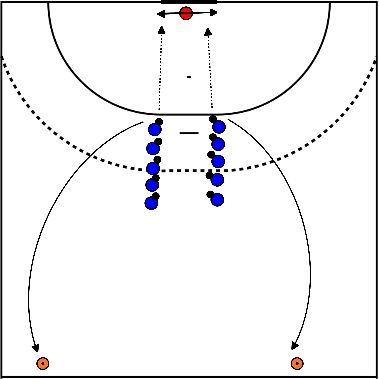
- You make 2 groups.
- 1 group has a vest.
- The groups must have an equal number.
- The children take turns standing in a circle. (So someone with a vest stands next to someone without vest).
- There are 2 balls and of each group 1 person has the ball (they face each other).
- You throw the ball as fast as possible to someone of your own group and try to catch the ball of the other group.
- If the ball falls, pick it up as quickly as possible and continue.
- Who will be first to catch the ball from the other team?
- If this goes well they all take 3 steps back and we increase the distance.
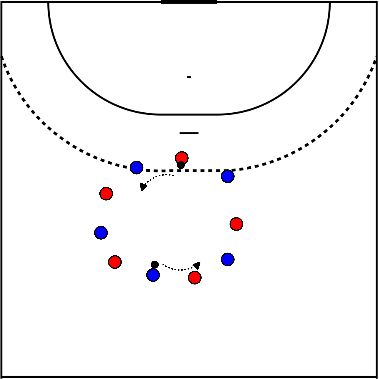
- Put a goal or put a mat in front of it and make compartments with tape or in some other way.
- Give the divided squares points.
- Each player may throw 3 times.
- Keeping track of the points and adding them up
- Player starts at the pylon in the middle.
- Sprints to the left pylon.
- Picks up the ball and works it towards the goal.
- Player sprints back to the pylon in the middle.
- Now sprints to the right pylon.
- Picks up the ball and finishes on the goal.
- Player sprints back to the centre pylon.
- Sprints to the second pylon on the left.
- Finishes with the goal.
- Player sprints back to the centre pylon.
- Sprints to the second pylon on the right.
- Finishes with the goal.
- The other players remain in their places, dribbling
- Or they can do strength training
- Jumping rope
- Dribble with the ball in a square.
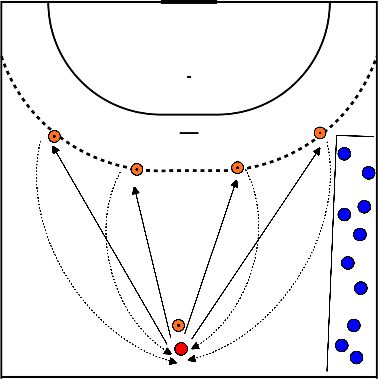
- All players are spread over the playing area.
- One player starts as the "hunter" and one player as the "prey".
- The "hunter" tries to catch the "prey".
- The "prey" can escape by running away or lying down next to another player.
- This player now becomes the "hunter" and the old "hunter" becomes the "prey".
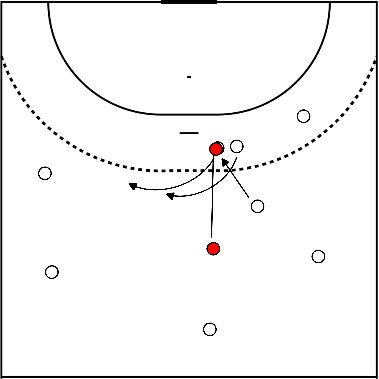
- This exercise is shown for 3 groups.
- Each team does a different exercise.
- This is done to show the possibilities and variations.
- The passes are only shown on the way out.
- Players continue with passes on the way back to their starting position. (5-10 passes are possible).
- The 1st group plays side passes inside the pylons and turns to the outside around the pylons and then plays long passes on the way back.
- The 2nd group plays side passes on the right side of the pylons and both turn left around the pylons and then play side passes again on the way back.
- The 3rd group runs (dribbles) around the pylons.
- All passes are possible, but the exercise is best for the quick, precise side pass. Also a good exercise for training acceleration.
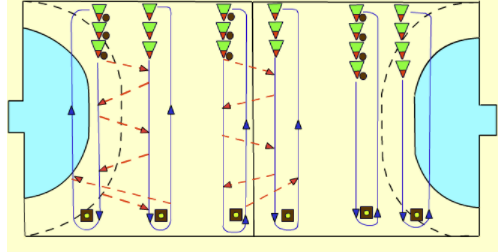
- Pairs stand in pairs in a large circle.
- In the middle are (number of pairs - 2) balls.
- On a signal the players start sprinting on the outside (remember to indicate the direction).
- When the player is back with his/her partner, she/he crawls between his/her legs and takes a ball from the middle.
- Those who have not conquered the ball must do some push-ups or something similar.
- Then they change places and start the game again.
- Variations:
- Sprinting with side steps
- Sprint backwards
- Sprint in different directions
- Lateral sliding passes to the left and right
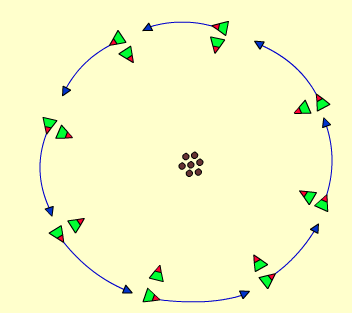
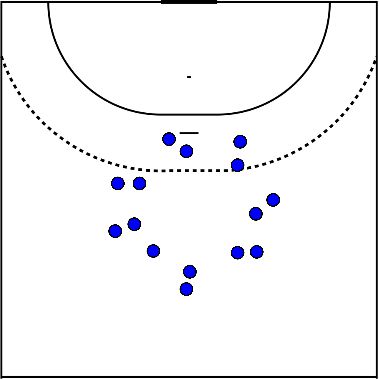
- 2 teams of 5 - 6 players.
- The exercise is performed as a relay race.
- The team runs a slalom around the pylons.
- The point from which the throw must be made is at the pylon at the free throw line.
- The moment the player finishes, the next player starts.
- Variations:
- The whole round is dribbled
- Each player makes 3 rounds:
- The first round the ball is carried between the pylons and dribbled along the long side
- The last round is the whole round dribbled.
- Carry the ball between the pylons and dribble the rest of the way
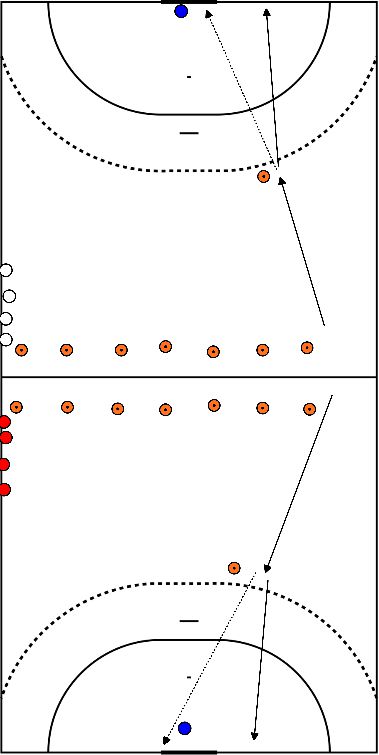
- LH starts from the corner
- Goes by sliding passes to the left around the 1st pylon
- Then you go backwards around the pylon, which is on the free throw line.
- From there forward again to the circle and sideways to the left around the next pylon.
- Then go backwards around the pylon, which is on the free throw line. Etc.
- The next LH does not have to wait until the first one is on the right side,
- But he must wait until there is enough space so as not to bump into the previous LH.
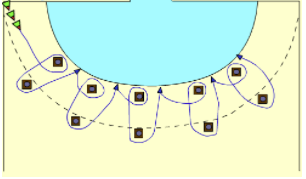
- Players stand back to back facing the wall at a distance of 4 to 5 feet.
- The first player throws the ball and gets out of the way of the second player who has to catch the ball.
- Then the second player throws and the third player catches the ball, etc.
- Variation:
- Larger run distance for being back in line.
- Put the pawn behind the row formed, they must first go around it before they can join the row.
- The first player has the ball.
- The ball is thrown against the wall and the first player jumps over the ball with their legs spread wide.
- The next player catches the ball and throws it against the wall.
- The first player joins the back of the row. Etc
- The exercise can also be performed as a competition.
- In which case the player who cannot catch the ball or jump over it must disappear from the line.
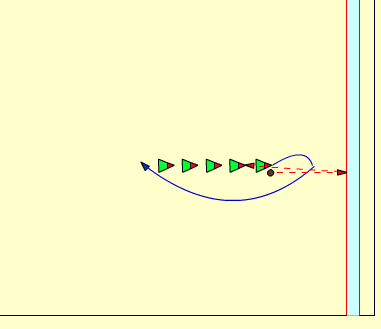
Throwing up in different ways in pairs
- With your right hand
- With your wrong hand
- With bounce
- Throwing to each other from a greater distance
- Throwing to each other from close range








